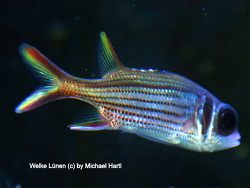Info
Dabei wird er bis zu 35 cm gross , was ihn wohl für die meisten Heimaquarien zu gross macht.
Und er wächst schneller als man denkt.
Er lebt meist alleine, manchmal aber auch in der Gruppe an Stellen, die reich mit Korallen besetzt sind.
Er benötigt ein Becken mit Unterständen und natürlich ausreichend Schwimmraum.
Frisst meist tierisches (Krebsartige), nimmt aber schnell Ersatznahrung in Form von Frost - und Flockenfutter an.
Ähnelt sehr dem N. sammara, wobei dieser nicht das durchgezogene, schwarze Band auf der Rückenflosse aufweist.







 Anders Poulsen, Dänemark
Anders Poulsen, Dänemark














